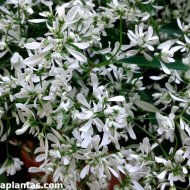Care of the plant Euphorbia hypericifolia or Graceful spurge |
|
The genus Euphorbia, family Euphorbiaceae, includes about 7,000 species of succulents, herbaceous and shrub plants of cosmopolitan distribution. Some shrub species are: Euphorbia hypericifolia, Euphorbia hierosolymitana, Euphorbia piscatoria, Euphorbia lambii, Euphorbia regis-jubae, Euphorbia umbellata, Euphorbia pulcherrima, Euphorbia cotinifolia, Euphorbia milii, Euphorbia characias, Euphorbia dendroides, Euphorbia rigida, Euphorbia leucocephala, Euphorbia anachoreta, Euphorbia tithymaloides. Common names: Graceful spurge, Milk spurge, Graceful Sandmat, St. John's wort-leaved spurge. Euphorbia hypericifolia is a perennial herbaceous plant (usually grown as an annual) with a rounded shape, very branched and fast growth that reaches 50 cm (1.64 feet) in height and width. The oval, dark blue-green leaves contrast with the abundant and long-lasting white flowers. It blooms from mid-spring to early autumn. Graceful spurge is used in rockeries, in flowerbeds, as an isolated specimen and in hanging pots and for patios and terraces. Euphorbia hypericifolia grows in full sun (temperate climates), semi-shade (Mediterranean climate) and shade exposures. It does not resist frost. If grown in a pot, it must be placed indoors if the winter is very cold. The soil can be normal garden soil with a little organic matter and well drained with coarse sand, although it can grow in sandy and poor soils. Graceful Sandmat has good resistance to drought. Water moderately, waiting for the substrate to dry; in summer, increase watering slightly. Fertilize every 30 days with mineral fertilizer in spring and summer. Euphorbia hypericifolia does not need pruning. Graceful spurge is a plant that is quite resistant to the usual pests and diseases but sensitive to cold and excess moisture in the roots. St. John's wort-leaved spurge is propagated from seed sown in spring and by division in winter. |
Images of the plant Euphorbia hypericifolia or Graceful spurge |
Find plants
Euphorbia hypericifolia or Graceful spurge | Care and Growing
© 2025 FavThemes


